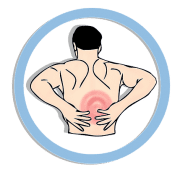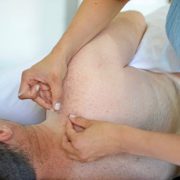Before Back Surgery – Try specialized physical therapy first
Approximately 500,000 Americans undergo back surgery to relieve their pain every year.
But the American Society of Anesthesiologists estimates that 20 – 40% of those surgeries fail – leaving folks worse off than before they were considering back surgery in the first place. And what happens when your first back surgery fails? You get a second surgery – and maybe even a third – to try and repair the failure. Once you go down that rabbit hole – your chances of success after back surgery drop significantly – down to a mere 5-15% success rate.
Knowing this, why do so many doctors and medical specialists continue to recommend back surgery without first exhausting all possible non-invasive solutions?
Well, when back surgery works, it can be a highly effective form of pain relief. So it’s attractive. But it’s important to note that within 3-5 years, according to research, many patients find themselves feeling worse than before surgery, and reverting back to relying on daily pain medication. People assume back surgery is going to be a pain-removing procedure, when in actuality it’s only a pain-reducing procedure. This was concluded by a 2003 study in the European Spine Journal that investigated the long-term success of posterolateral spinal fusion. They found only 20% of the subjects continued to be pain free after 5 years, and warned against patients relying on surgery as a long-term fix.
Given the list of potential complications from back surgery – including infection, blood clots, nerve damage, adverse reactions to anesthesia, and incomplete pain relief – it’s imperative you consider all other non-invasive treatment options first. It may take longer for you to experience pain-relief, but the results will be longer-lasting and you can avoid putting yourself at risk for irreversible complications.
Examples of non-invasive treatment options include chiropractic treatment, acupuncture, massage, shockwave therapy, therapeutic exercise, and of course, physical therapy. But the biggest objection I hear from folks against trying some of these non-invasive solutions – often for a second or third round – is that they’ve “tried it all” and it didn’t work. But more often than not, after diving in further, I find that patients have “cherry-picked” their treatment choices over the years without any real strategy – or they’re trying way too many things and all at once.
Not only does this get exhausting, but it’s ineffective.
Passive modalities (acupuncture, massage, chiropractic treatment, etc) are great at reducing pain but you need to match them up with specialized and corrective movement strategies to make the effects last. Traditional physical therapy, Pilates, and personal trainers can all help you to feel better as well, but if the exercises aren’t specialized enough, they won’t have any effect or could even make you feel worse. Without a strategic plan, and putting all of these things together and in the right order, you’ll have a hard time getting rid of your back pain naturally.
Over my 22 years of working with patients suffering from back pain and sciatica, I say all of this from experience. For the first 10 years of my career I was what I call a “generalist”. I worked in traditional physical therapy settings where I followed doctor’s orders, relied on insurance to dictate what I could and couldn’t do, and I used many of the passive modalities already mentioned above along with (what I thought at the time) were the best core training and back stabilizing exercises.
It wasn’t until I went on to learn specialist techniques and truly understand how back pain actually manifested, that I was finally able to help people not only get rid of back pain – but keep it gone for good and avoid surgery. It is entirely possible to treat back pain on your own and get rid of it naturally – and then maintain and prevent it with the right types of exercise – but you really need to work with a specialist who can guide you through this process.
So what’s the difference between a physical therapy specialist who treats back pain versus a generalist?
They’ll do their own examination and come up with their own diagnosis, they won’t rely on just passive modalities to help you, and you’ll have an extremely precise and customized exercise prescription instead of a bunch of general exercises (that you could honestly learn from YouTube). If you’re suffering from a back problem and want to avoid procedures and surgery at all costs – it’s really important that you don’t just stop with general physical therapy or chiropractic treatment and assume you’ve exhausted all of your options. Look for someone who specializes in back pain in the way I’ve just described, and has a proven track record for coming up with strategic treatment plans that last.
Eighty percent of all back problems are mechanical in nature and come on slowly over time from repeatedly moving poorly or from your lifestyle (even when your back pain seems to have come on suddenly and out of nowhere). Because of this, all of the passive modalities, including back surgery, and general exercises in the world will not correct these problems – and your back pain and associated symptoms will continue to return until you have a full understanding of what’s going on and can correct them. When you find a specialist who can do this for you – it’s life changing. Before you consider back surgery, consider working with a specialized physical therapist, especially if you’re already tried regular physical therapy and it failed. They do exist – and if you need help finding one – please reach out. I’m happy to help you locate one in your area.
Dr. Carrie Jose, Physical Therapist and Pilates expert, owns CJ Physical Therapy & Pilates in Portsmouth and writes for Seacoast Media Group. To request a free copy of her guide to back pain CLICK HERE or to get in touch, email her at [email protected].











